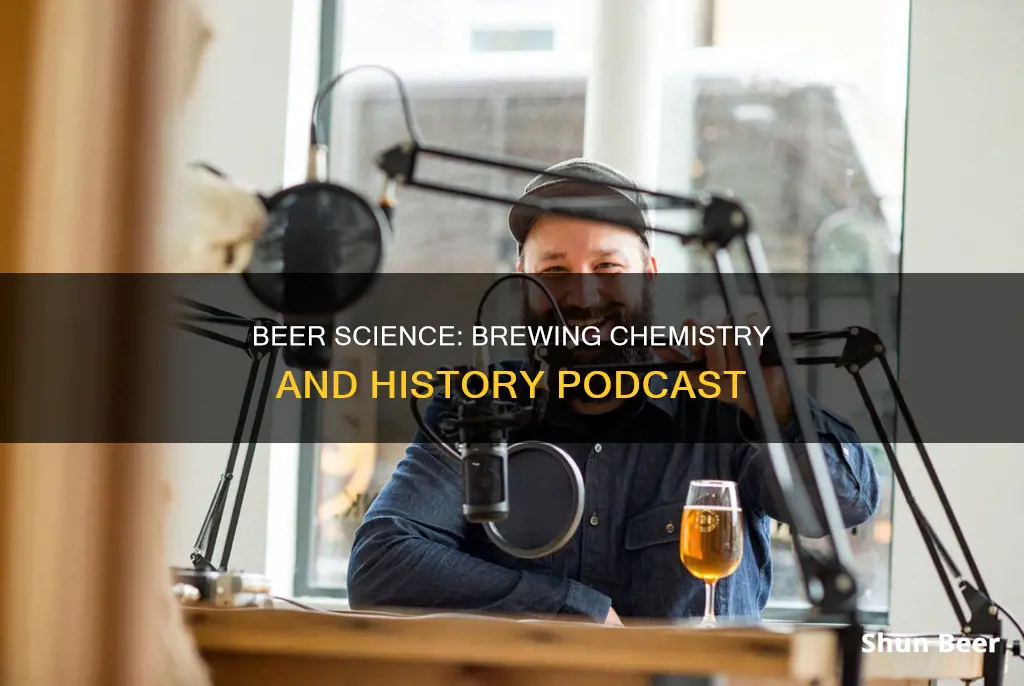
Beer is as old as civilization, and the process of brewing it has a rich history. The How Beer Works podcast explores the history of beer, the brewing process, and the latest developments in the beer industry. With a wide range of beer-related topics, from the science of brewing to the art of crafting unique beers, this podcast is perfect for both beer enthusiasts and professionals in the industry. Whether you're a homebrewer looking to perfect your craft or simply someone who enjoys kicking back with a cold beer, How Beer Works has something for everyone. So, grab your favourite brew and get ready to dive into the fascinating world of beer!
| Characteristics | Values |
|---|---|
| Date | May 27, 2017 |
| Duration | 48 minutes |
| Host | Josh and Chuck |
| Topic | History of beer and how it's made |
What You'll Learn

The history of beer
Beer is one of the oldest human-produced drinks, with evidence of its consumption dating back thousands of years. Here is a brief history of beer:
Ancient Times
The first fermented beverages likely emerged alongside the development of cereal agriculture around 12,000 years ago. Ancient civilisations such as the Sumerians in Mesopotamia (modern-day Iraq) and the Egyptians are known to have consumed beer regularly, considering it sacred and a gift from the gods. Beer was often used as compensation for labour, and it was common for workers to receive beer rations, with the amount depending on their social standing. The ancient Greeks and Romans also brewed beer, although they preferred wine, considering beer a barbaric drink.
Middle Ages
During the Middle Ages, beer was mostly produced in monasteries across Europe. It was a perfect beverage for monks during fasting periods due to its high nutritional value. Some monks were allowed to drink up to five litres of beer per day! Beer production helped monasteries survive the Dark Ages, as they sold beer to make a living. Around this time, people started using hops in the brewing process, refining its taste and making it less bitter.
Commercialisation
In the 13th century, beer was finally produced commercially in Germany, England, and Austria. The Germans set the standard for most beer makers in Europe with their high-quality, cold beer. The Renaissance period saw the emergence of the German Reinheitsgebot (Beer Purity Law), which decreed that beer could only contain water, barley, and hops.
Industrial Revolution
The Industrial Revolution mechanised brewing, improving control over the process with the use of thermometers and saccharometers. This led to the mass production of beer and the establishment of large-scale breweries. The French chemist Louis Pasteur played a crucial role in the 19th century by studying fermentation and establishing many of the microbiological practices still used today.
Modern Times
Today, the brewing industry is a global business, with a diverse range of beer styles and flavours available worldwide. Consumers can choose from a variety of beers, including lagers, ales, stouts, IPAs, and craft beers. The craft brewing movement, which originated in the USA, has led to innovative flavours and production techniques, distancing itself from classic lagers and mass-produced beers.
Beer and Blood Work: What's the Connection?
You may want to see also

How beer is made
Beer is one of the world's oldest alcoholic drinks, with evidence of its production dating back to ancient civilisations. The process of making beer is known as brewing, and it involves a few key steps. Firstly, there's malting, where grain is soaked, germinated, and then dried in a kiln. This process produces enzymes that convert starches in the grain into fermentable sugars. The grain is then milled or crushed, and mixed with hot water in a process known as "mashing". During mashing, the starches are converted into sugars, creating a sweet liquid called wort.
The next step is to separate the wort from the grain and then boil it, usually for about an hour. Hops are added during this boiling stage, acting as a source of bitterness, flavour, and aroma. The longer the hops are boiled, the more bitterness they contribute to the beer. After boiling, the hopped wort is cooled and yeast is added, beginning the fermentation process. Fermentation is what turns the wort into beer, as the yeast feeds on the sugars and produces alcohol and carbon dioxide.
The final steps involve separating the yeast from the young beer, followed by ageing and maturing. The resulting beverage is then packaged into casks, kegs, cans, or bottles.
Understanding Beer Distribution: From Brewery to Glass
You may want to see also

Beer and bread
Ingredients
- Water—The core of both bread and beer and, indeed, all life on the planet. In many periods of history, beer was safer to drink than water, as the boiling and fermentation processes removed contaminants.
- Grain—The material that creates the nutritive qualities of both bread and beer. While most bread is made from wheat and most beer is made from barley, this is not a hard and fast rule.
- Yeast—Both products share a primary yeasting agent: Saccharomyces cerevisiae. Lager yeast is Saccharomyces pastorianus, which is still related to Saccharomyces cerevisiae.
- Salt—Salt in bread is included to slow fermentation and inhibit water absorption. In beer, 'water salts' are added to the brewing liquor to create water chemistry that makes better beer.
- Botanicals—Botanicals provide flavour for both products, with hops being a beer-centric ingredient. Their preservative qualities benefit beer, especially in ancient times. However, other herbs and blends like gruit (used for hundreds of years before the introduction of hops) were likely used in bread production as well.
Chemical Agents
The browning of bread in the oven and caramelization of wort in the kettle both rely on Malliard reactions to create flavours that are key to the character of both products. And both beer and (leavened) bread depend on the action of yeast, albeit in slightly different ways.
History
Throughout history, both beer and bread were critical nutritive sources in many parts of the world. Beer was safer to drink than water, and both provided much-needed calories.
The production of bread with yeast may even pre-date the production of beer. It is theorised that beer production may have begun when a piece of bread got wet and inadvertently fermented.
The oldest record of brewing is around 6,000 years old in Sumer. The ancient Sumerians had a hymn to Ninkasi, the goddess of brewing, which included a recipe for beer.
Beer was also being brewed in what is now China over 7,000 years ago, and in Iran over 3,000 years ago. The Ancient Egyptians had a goddess of beer, Tenenit, and while the Romans brewed beer, it never really caught on as they were busy with wine. More recently, beer was being brewed in Bavaria as early as 800 years ago.
The history of breadmaking is similarly spread across the planet. The Ancient Egyptians are credited with making the first leavened bread, but unleavened bread (made from mixed crushed grains with water and 'baked' on hot stones in the sun or hot ashes) dates to much earlier. There is evidence of breadmaking at a 14,500-year-old Natufian site in modern-day Jordan.
Modern Interpretations
Given the intertwined history of beer and bread, aspects of one can be used to create a version of the other, drawing on elements of the past to make modern interpretations. For example, heirloom grains like emmer, einkorn, and spelt have been reincorporated into baking and could also be used in brewing beer.
There are even beers brewed using bread, like Seto Koduolu from Russia and Estonia, Bouza from Egypt and Sudan, and Kvass, a fermented drink made from bread that is a cultural mainstay in many areas of Eastern Europe.
Beer Fast: Does It Work Quickly?
You may want to see also

Beer and civilisation
Beer is one of the world's oldest alcoholic drinks, with archaeological evidence of its existence dating back to the earliest civilisations. It is believed that beer may have been known in Neolithic Europe as far back as 5,000 years ago, and was also recorded in the written history of ancient Egypt.
The earliest archaeological evidence of fermentation consists of 13,000-year-old residues of a beer found in the Raqefet Cave in the Carmel Mountains near Haifa in Israel. There is also evidence of beer production at Göbekli Tepe during the Pre-Pottery Neolithic (around 8500 BC to 5500 BC).
The earliest written records of brewing come from Mesopotamia (ancient Iraq). These include a 3,900-year-old Sumerian poem honouring Ninkasi, the patron goddess of brewing, which contains the oldest surviving beer recipe. Beer is also mentioned in the Epic of Gilgamesh, where the 'wild man' Enkidu is given beer to drink.
Beer was often the only safe liquid to drink when clean water was rare, and it was also an important source of essential vitamins and nutrients for ancient peoples. It is thought that the discovery of beer may have occurred when ancient peoples heated a gruel made from grains and left it to sit, leading to fermentation.
The invention of beer, and bread, may have contributed to the development of technology and static civilisation. Beer allowed people to break free from rigid social codes and encouraged exploration, artistic expression, romance, inventiveness and experimentation—all factors that make for a vibrant civilisation.
Beer was also vital to the grain-growing civilisations of Eurasian and North African antiquity, including Egypt. During the construction of the Great Pyramids in Giza, Egypt, each worker was given a daily ration of four to five litres of beer, which provided crucial nutrition and refreshment.
The production and consumption of beer have certainly played a significant role in the development of human societies and civilisations throughout history.
Buttermilk Beer Batter: Does Druesteaz Mix Work?
You may want to see also

Beer and gender
Inka Kosonen, who has conducted research for her PhD thesis on making the British craft beer industry more inclusive, highlighted several challenges faced by women in the beer industry. These include a lack of representation, unequal power dynamics, and the need for more research. Kosonen emphasised the importance of mentoring and creating new narratives to promote gender equality. She also pointed out the need to address basic female needs, such as the availability of sanitary bins in workplace toilets, which are often overlooked.
Podcasts such as "False Bottomed Girls", "Brews with Broads", "Beer Beauty", and "Boys are from Märzen" are leading the way in giving voice to diversity and inclusion in the beer industry. These podcasts are hosted by women and non-binary individuals, and they aim to create a space for women and others to learn about brewing techniques, beer styles, history, and ingredients. By sharing their stories and experiences, these podcasts are helping to break down barriers and increase visibility for underrepresented groups in the beer industry.
Additionally, events like the Summer Hop, hosted by Women On Tap, provide a platform for discussions on inclusivity and gender equality in the beer industry. While these initiatives are a great start, Kosonen emphasised that more needs to be done to address the structural problems and power dynamics that prevent women from having equal power in the industry.
The Science Behind Beer: Brewing Chemistry Explained
You may want to see also
Frequently asked questions
The 'How Beer Works' podcast is an episode of the 'Stuff You Should Know' podcast, which covers a wide range of topics. This episode focuses on the history of beer and how it's made.
The 'How Beer Works' podcast is hosted by Josh and Chuck.
The 'How Beer Works' podcast was released on May 27, 2017, with a duration of 48 minutes.
The podcast covers a range of topics, including the ancient history of beer, the brewing process, different types of beer, and fun facts about beer.







